Case Study - Colorectal Cancer: Nursing Process and Holistic Care
VerifiedAdded on 2022/11/13
|12
|3804
|337
AI Summary
This case study covers a patient suffering from colorectal cancer and the nursing process involved in providing holistic care. It includes a summary of the condition, surgical procedure, nursing process, and care plans.
Contribute Materials
Your contribution can guide someone’s learning journey. Share your
documents today.

Running head: CASE STUDY
Case Study- Colorectal Cancer
Name of the Student
Name of the University
Author Note
Case Study- Colorectal Cancer
Name of the Student
Name of the University
Author Note
Secure Best Marks with AI Grader
Need help grading? Try our AI Grader for instant feedback on your assignments.
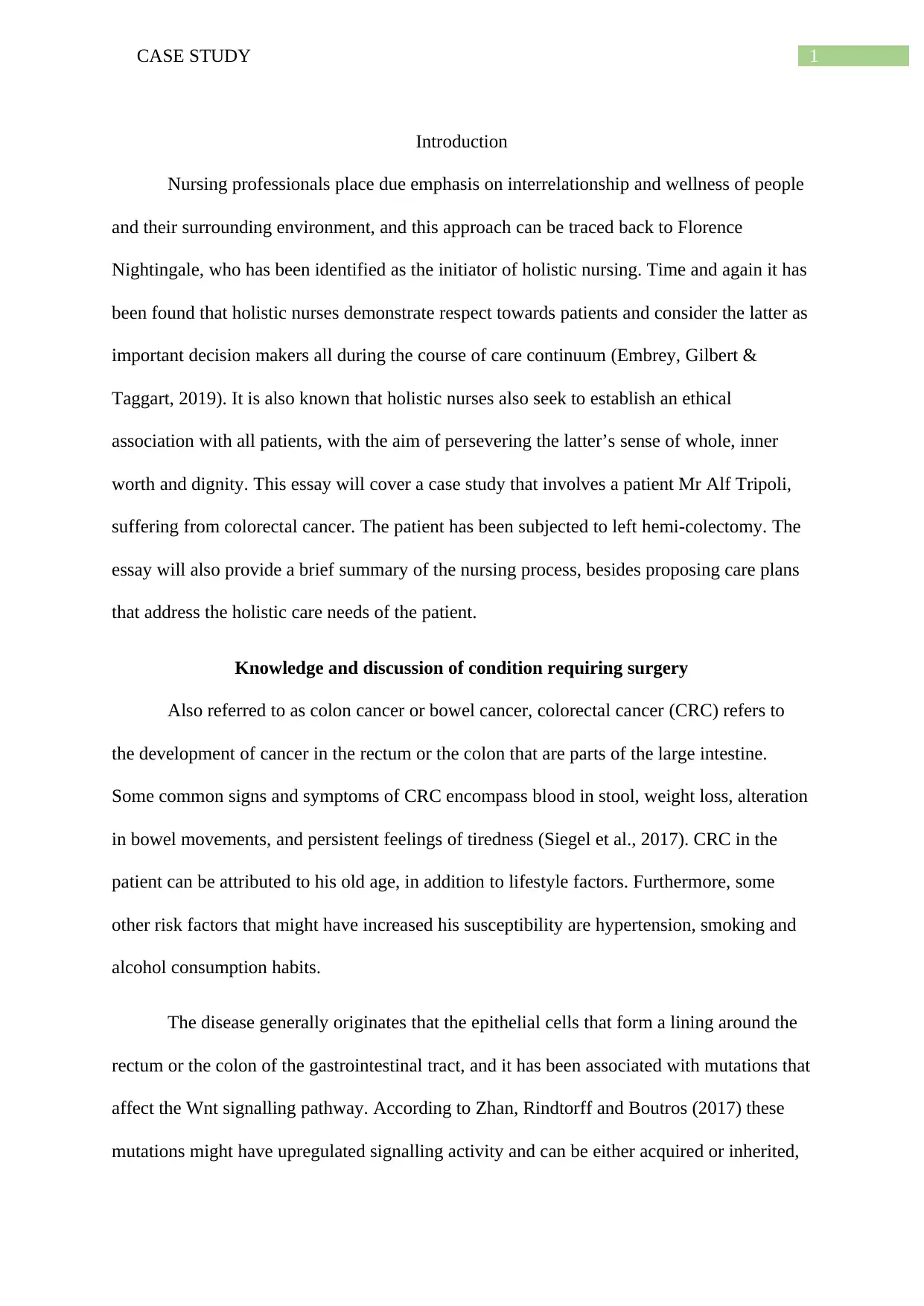
1CASE STUDY
Introduction
Nursing professionals place due emphasis on interrelationship and wellness of people
and their surrounding environment, and this approach can be traced back to Florence
Nightingale, who has been identified as the initiator of holistic nursing. Time and again it has
been found that holistic nurses demonstrate respect towards patients and consider the latter as
important decision makers all during the course of care continuum (Embrey, Gilbert &
Taggart, 2019). It is also known that holistic nurses also seek to establish an ethical
association with all patients, with the aim of persevering the latter’s sense of whole, inner
worth and dignity. This essay will cover a case study that involves a patient Mr Alf Tripoli,
suffering from colorectal cancer. The patient has been subjected to left hemi-colectomy. The
essay will also provide a brief summary of the nursing process, besides proposing care plans
that address the holistic care needs of the patient.
Knowledge and discussion of condition requiring surgery
Also referred to as colon cancer or bowel cancer, colorectal cancer (CRC) refers to
the development of cancer in the rectum or the colon that are parts of the large intestine.
Some common signs and symptoms of CRC encompass blood in stool, weight loss, alteration
in bowel movements, and persistent feelings of tiredness (Siegel et al., 2017). CRC in the
patient can be attributed to his old age, in addition to lifestyle factors. Furthermore, some
other risk factors that might have increased his susceptibility are hypertension, smoking and
alcohol consumption habits.
The disease generally originates that the epithelial cells that form a lining around the
rectum or the colon of the gastrointestinal tract, and it has been associated with mutations that
affect the Wnt signalling pathway. According to Zhan, Rindtorff and Boutros (2017) these
mutations might have upregulated signalling activity and can be either acquired or inherited,
Introduction
Nursing professionals place due emphasis on interrelationship and wellness of people
and their surrounding environment, and this approach can be traced back to Florence
Nightingale, who has been identified as the initiator of holistic nursing. Time and again it has
been found that holistic nurses demonstrate respect towards patients and consider the latter as
important decision makers all during the course of care continuum (Embrey, Gilbert &
Taggart, 2019). It is also known that holistic nurses also seek to establish an ethical
association with all patients, with the aim of persevering the latter’s sense of whole, inner
worth and dignity. This essay will cover a case study that involves a patient Mr Alf Tripoli,
suffering from colorectal cancer. The patient has been subjected to left hemi-colectomy. The
essay will also provide a brief summary of the nursing process, besides proposing care plans
that address the holistic care needs of the patient.
Knowledge and discussion of condition requiring surgery
Also referred to as colon cancer or bowel cancer, colorectal cancer (CRC) refers to
the development of cancer in the rectum or the colon that are parts of the large intestine.
Some common signs and symptoms of CRC encompass blood in stool, weight loss, alteration
in bowel movements, and persistent feelings of tiredness (Siegel et al., 2017). CRC in the
patient can be attributed to his old age, in addition to lifestyle factors. Furthermore, some
other risk factors that might have increased his susceptibility are hypertension, smoking and
alcohol consumption habits.
The disease generally originates that the epithelial cells that form a lining around the
rectum or the colon of the gastrointestinal tract, and it has been associated with mutations that
affect the Wnt signalling pathway. According to Zhan, Rindtorff and Boutros (2017) these
mutations might have upregulated signalling activity and can be either acquired or inherited,
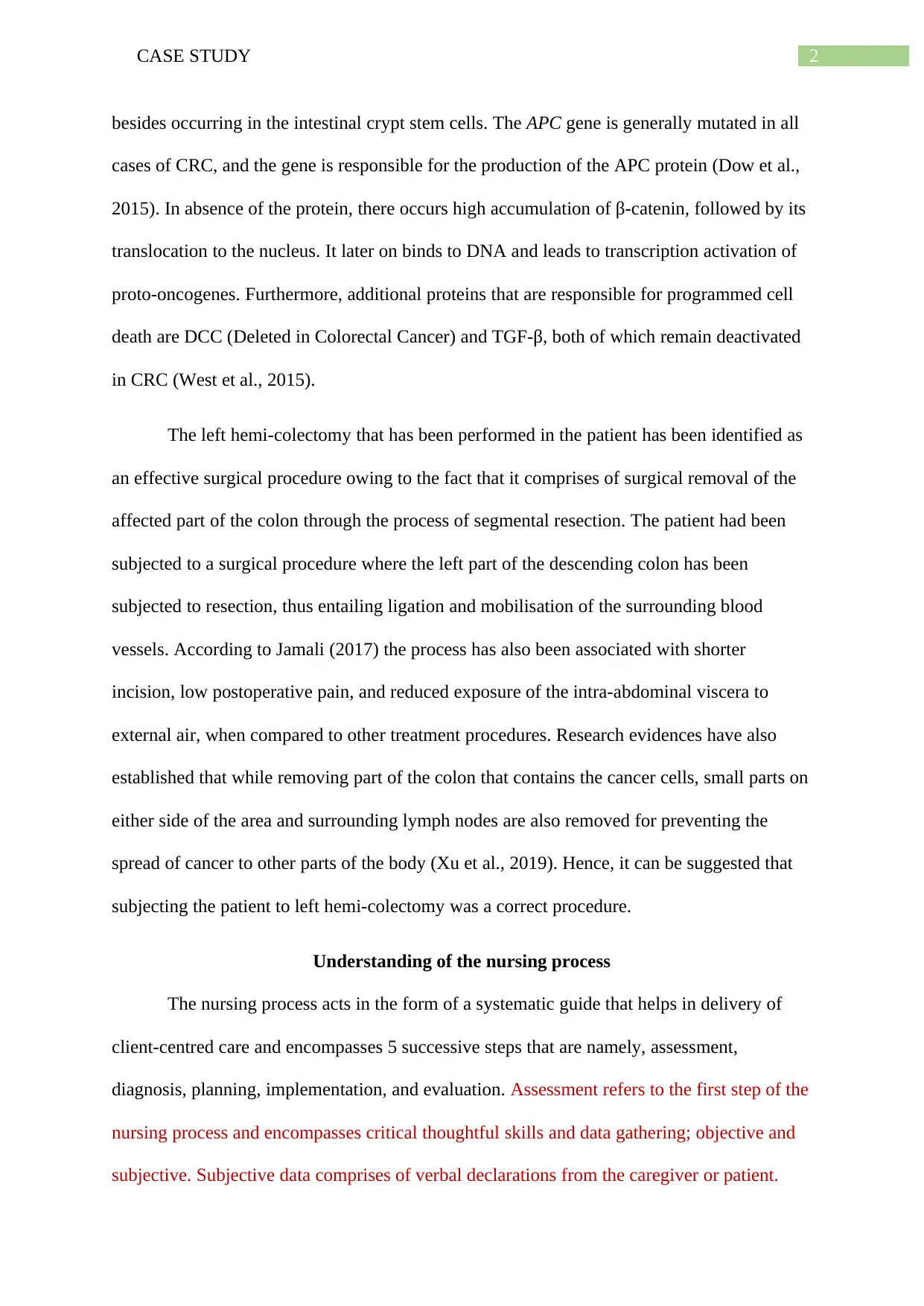
2CASE STUDY
besides occurring in the intestinal crypt stem cells. The APC gene is generally mutated in all
cases of CRC, and the gene is responsible for the production of the APC protein (Dow et al.,
2015). In absence of the protein, there occurs high accumulation of β-catenin, followed by its
translocation to the nucleus. It later on binds to DNA and leads to transcription activation of
proto-oncogenes. Furthermore, additional proteins that are responsible for programmed cell
death are DCC (Deleted in Colorectal Cancer) and TGF-β, both of which remain deactivated
in CRC (West et al., 2015).
The left hemi-colectomy that has been performed in the patient has been identified as
an effective surgical procedure owing to the fact that it comprises of surgical removal of the
affected part of the colon through the process of segmental resection. The patient had been
subjected to a surgical procedure where the left part of the descending colon has been
subjected to resection, thus entailing ligation and mobilisation of the surrounding blood
vessels. According to Jamali (2017) the process has also been associated with shorter
incision, low postoperative pain, and reduced exposure of the intra-abdominal viscera to
external air, when compared to other treatment procedures. Research evidences have also
established that while removing part of the colon that contains the cancer cells, small parts on
either side of the area and surrounding lymph nodes are also removed for preventing the
spread of cancer to other parts of the body (Xu et al., 2019). Hence, it can be suggested that
subjecting the patient to left hemi-colectomy was a correct procedure.
Understanding of the nursing process
The nursing process acts in the form of a systematic guide that helps in delivery of
client-centred care and encompasses 5 successive steps that are namely, assessment,
diagnosis, planning, implementation, and evaluation. Assessment refers to the first step of the
nursing process and encompasses critical thoughtful skills and data gathering; objective and
subjective. Subjective data comprises of verbal declarations from the caregiver or patient.
besides occurring in the intestinal crypt stem cells. The APC gene is generally mutated in all
cases of CRC, and the gene is responsible for the production of the APC protein (Dow et al.,
2015). In absence of the protein, there occurs high accumulation of β-catenin, followed by its
translocation to the nucleus. It later on binds to DNA and leads to transcription activation of
proto-oncogenes. Furthermore, additional proteins that are responsible for programmed cell
death are DCC (Deleted in Colorectal Cancer) and TGF-β, both of which remain deactivated
in CRC (West et al., 2015).
The left hemi-colectomy that has been performed in the patient has been identified as
an effective surgical procedure owing to the fact that it comprises of surgical removal of the
affected part of the colon through the process of segmental resection. The patient had been
subjected to a surgical procedure where the left part of the descending colon has been
subjected to resection, thus entailing ligation and mobilisation of the surrounding blood
vessels. According to Jamali (2017) the process has also been associated with shorter
incision, low postoperative pain, and reduced exposure of the intra-abdominal viscera to
external air, when compared to other treatment procedures. Research evidences have also
established that while removing part of the colon that contains the cancer cells, small parts on
either side of the area and surrounding lymph nodes are also removed for preventing the
spread of cancer to other parts of the body (Xu et al., 2019). Hence, it can be suggested that
subjecting the patient to left hemi-colectomy was a correct procedure.
Understanding of the nursing process
The nursing process acts in the form of a systematic guide that helps in delivery of
client-centred care and encompasses 5 successive steps that are namely, assessment,
diagnosis, planning, implementation, and evaluation. Assessment refers to the first step of the
nursing process and encompasses critical thoughtful skills and data gathering; objective and
subjective. Subjective data comprises of verbal declarations from the caregiver or patient.
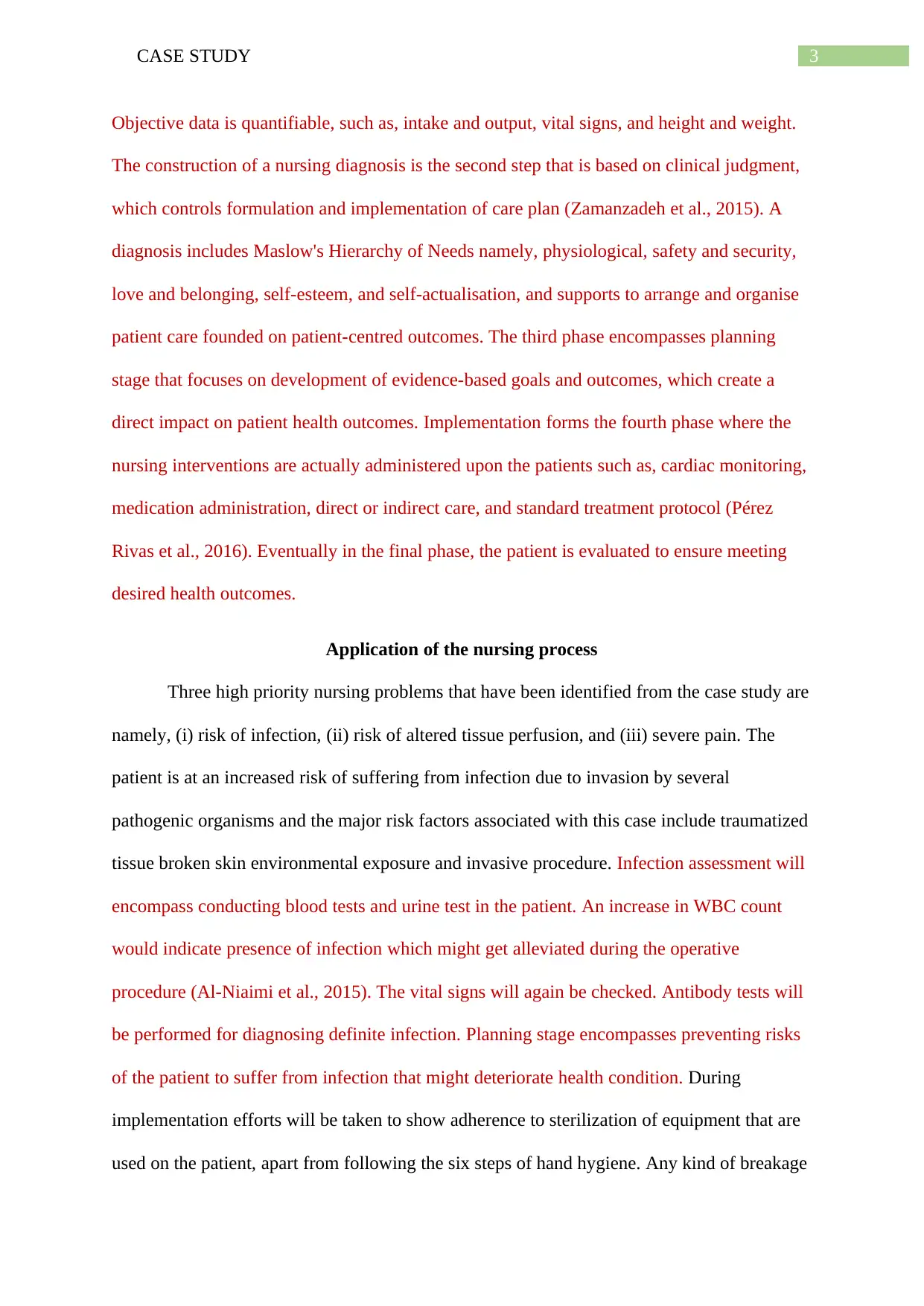
3CASE STUDY
Objective data is quantifiable, such as, intake and output, vital signs, and height and weight.
The construction of a nursing diagnosis is the second step that is based on clinical judgment,
which controls formulation and implementation of care plan (Zamanzadeh et al., 2015). A
diagnosis includes Maslow's Hierarchy of Needs namely, physiological, safety and security,
love and belonging, self-esteem, and self-actualisation, and supports to arrange and organise
patient care founded on patient-centred outcomes. The third phase encompasses planning
stage that focuses on development of evidence-based goals and outcomes, which create a
direct impact on patient health outcomes. Implementation forms the fourth phase where the
nursing interventions are actually administered upon the patients such as, cardiac monitoring,
medication administration, direct or indirect care, and standard treatment protocol (Pérez
Rivas et al., 2016). Eventually in the final phase, the patient is evaluated to ensure meeting
desired health outcomes.
Application of the nursing process
Three high priority nursing problems that have been identified from the case study are
namely, (i) risk of infection, (ii) risk of altered tissue perfusion, and (iii) severe pain. The
patient is at an increased risk of suffering from infection due to invasion by several
pathogenic organisms and the major risk factors associated with this case include traumatized
tissue broken skin environmental exposure and invasive procedure. Infection assessment will
encompass conducting blood tests and urine test in the patient. An increase in WBC count
would indicate presence of infection which might get alleviated during the operative
procedure (Al-Niaimi et al., 2015). The vital signs will again be checked. Antibody tests will
be performed for diagnosing definite infection. Planning stage encompasses preventing risks
of the patient to suffer from infection that might deteriorate health condition. During
implementation efforts will be taken to show adherence to sterilization of equipment that are
used on the patient, apart from following the six steps of hand hygiene. Any kind of breakage
Objective data is quantifiable, such as, intake and output, vital signs, and height and weight.
The construction of a nursing diagnosis is the second step that is based on clinical judgment,
which controls formulation and implementation of care plan (Zamanzadeh et al., 2015). A
diagnosis includes Maslow's Hierarchy of Needs namely, physiological, safety and security,
love and belonging, self-esteem, and self-actualisation, and supports to arrange and organise
patient care founded on patient-centred outcomes. The third phase encompasses planning
stage that focuses on development of evidence-based goals and outcomes, which create a
direct impact on patient health outcomes. Implementation forms the fourth phase where the
nursing interventions are actually administered upon the patients such as, cardiac monitoring,
medication administration, direct or indirect care, and standard treatment protocol (Pérez
Rivas et al., 2016). Eventually in the final phase, the patient is evaluated to ensure meeting
desired health outcomes.
Application of the nursing process
Three high priority nursing problems that have been identified from the case study are
namely, (i) risk of infection, (ii) risk of altered tissue perfusion, and (iii) severe pain. The
patient is at an increased risk of suffering from infection due to invasion by several
pathogenic organisms and the major risk factors associated with this case include traumatized
tissue broken skin environmental exposure and invasive procedure. Infection assessment will
encompass conducting blood tests and urine test in the patient. An increase in WBC count
would indicate presence of infection which might get alleviated during the operative
procedure (Al-Niaimi et al., 2015). The vital signs will again be checked. Antibody tests will
be performed for diagnosing definite infection. Planning stage encompasses preventing risks
of the patient to suffer from infection that might deteriorate health condition. During
implementation efforts will be taken to show adherence to sterilization of equipment that are
used on the patient, apart from following the six steps of hand hygiene. Any kind of breakage
Secure Best Marks with AI Grader
Need help grading? Try our AI Grader for instant feedback on your assignments.
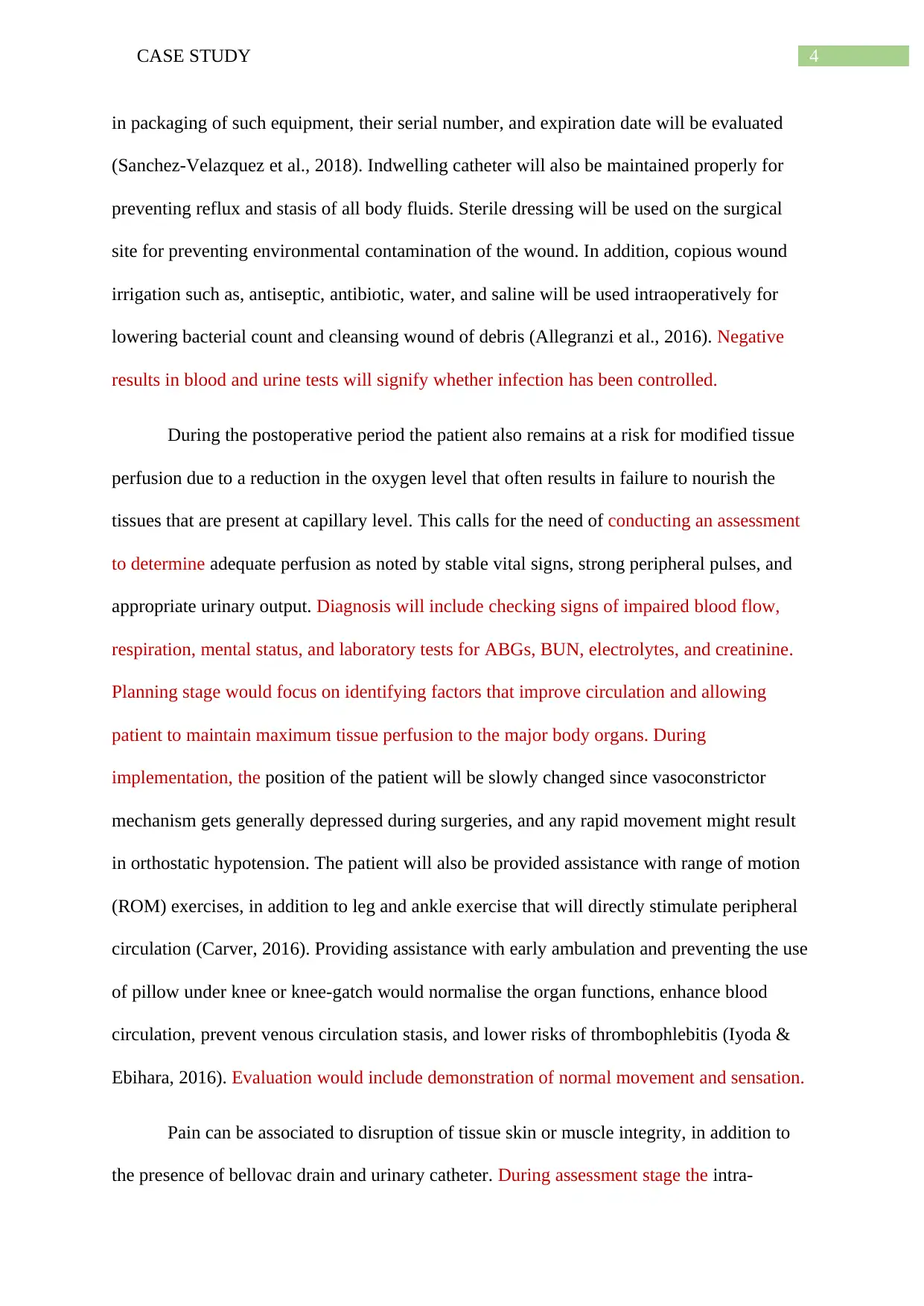
4CASE STUDY
in packaging of such equipment, their serial number, and expiration date will be evaluated
(Sanchez-Velazquez et al., 2018). Indwelling catheter will also be maintained properly for
preventing reflux and stasis of all body fluids. Sterile dressing will be used on the surgical
site for preventing environmental contamination of the wound. In addition, copious wound
irrigation such as, antiseptic, antibiotic, water, and saline will be used intraoperatively for
lowering bacterial count and cleansing wound of debris (Allegranzi et al., 2016). Negative
results in blood and urine tests will signify whether infection has been controlled.
During the postoperative period the patient also remains at a risk for modified tissue
perfusion due to a reduction in the oxygen level that often results in failure to nourish the
tissues that are present at capillary level. This calls for the need of conducting an assessment
to determine adequate perfusion as noted by stable vital signs, strong peripheral pulses, and
appropriate urinary output. Diagnosis will include checking signs of impaired blood flow,
respiration, mental status, and laboratory tests for ABGs, BUN, electrolytes, and creatinine.
Planning stage would focus on identifying factors that improve circulation and allowing
patient to maintain maximum tissue perfusion to the major body organs. During
implementation, the position of the patient will be slowly changed since vasoconstrictor
mechanism gets generally depressed during surgeries, and any rapid movement might result
in orthostatic hypotension. The patient will also be provided assistance with range of motion
(ROM) exercises, in addition to leg and ankle exercise that will directly stimulate peripheral
circulation (Carver, 2016). Providing assistance with early ambulation and preventing the use
of pillow under knee or knee-gatch would normalise the organ functions, enhance blood
circulation, prevent venous circulation stasis, and lower risks of thrombophlebitis (Iyoda &
Ebihara, 2016). Evaluation would include demonstration of normal movement and sensation.
Pain can be associated to disruption of tissue skin or muscle integrity, in addition to
the presence of bellovac drain and urinary catheter. During assessment stage the intra-
in packaging of such equipment, their serial number, and expiration date will be evaluated
(Sanchez-Velazquez et al., 2018). Indwelling catheter will also be maintained properly for
preventing reflux and stasis of all body fluids. Sterile dressing will be used on the surgical
site for preventing environmental contamination of the wound. In addition, copious wound
irrigation such as, antiseptic, antibiotic, water, and saline will be used intraoperatively for
lowering bacterial count and cleansing wound of debris (Allegranzi et al., 2016). Negative
results in blood and urine tests will signify whether infection has been controlled.
During the postoperative period the patient also remains at a risk for modified tissue
perfusion due to a reduction in the oxygen level that often results in failure to nourish the
tissues that are present at capillary level. This calls for the need of conducting an assessment
to determine adequate perfusion as noted by stable vital signs, strong peripheral pulses, and
appropriate urinary output. Diagnosis will include checking signs of impaired blood flow,
respiration, mental status, and laboratory tests for ABGs, BUN, electrolytes, and creatinine.
Planning stage would focus on identifying factors that improve circulation and allowing
patient to maintain maximum tissue perfusion to the major body organs. During
implementation, the position of the patient will be slowly changed since vasoconstrictor
mechanism gets generally depressed during surgeries, and any rapid movement might result
in orthostatic hypotension. The patient will also be provided assistance with range of motion
(ROM) exercises, in addition to leg and ankle exercise that will directly stimulate peripheral
circulation (Carver, 2016). Providing assistance with early ambulation and preventing the use
of pillow under knee or knee-gatch would normalise the organ functions, enhance blood
circulation, prevent venous circulation stasis, and lower risks of thrombophlebitis (Iyoda &
Ebihara, 2016). Evaluation would include demonstration of normal movement and sensation.
Pain can be associated to disruption of tissue skin or muscle integrity, in addition to
the presence of bellovac drain and urinary catheter. During assessment stage the intra-
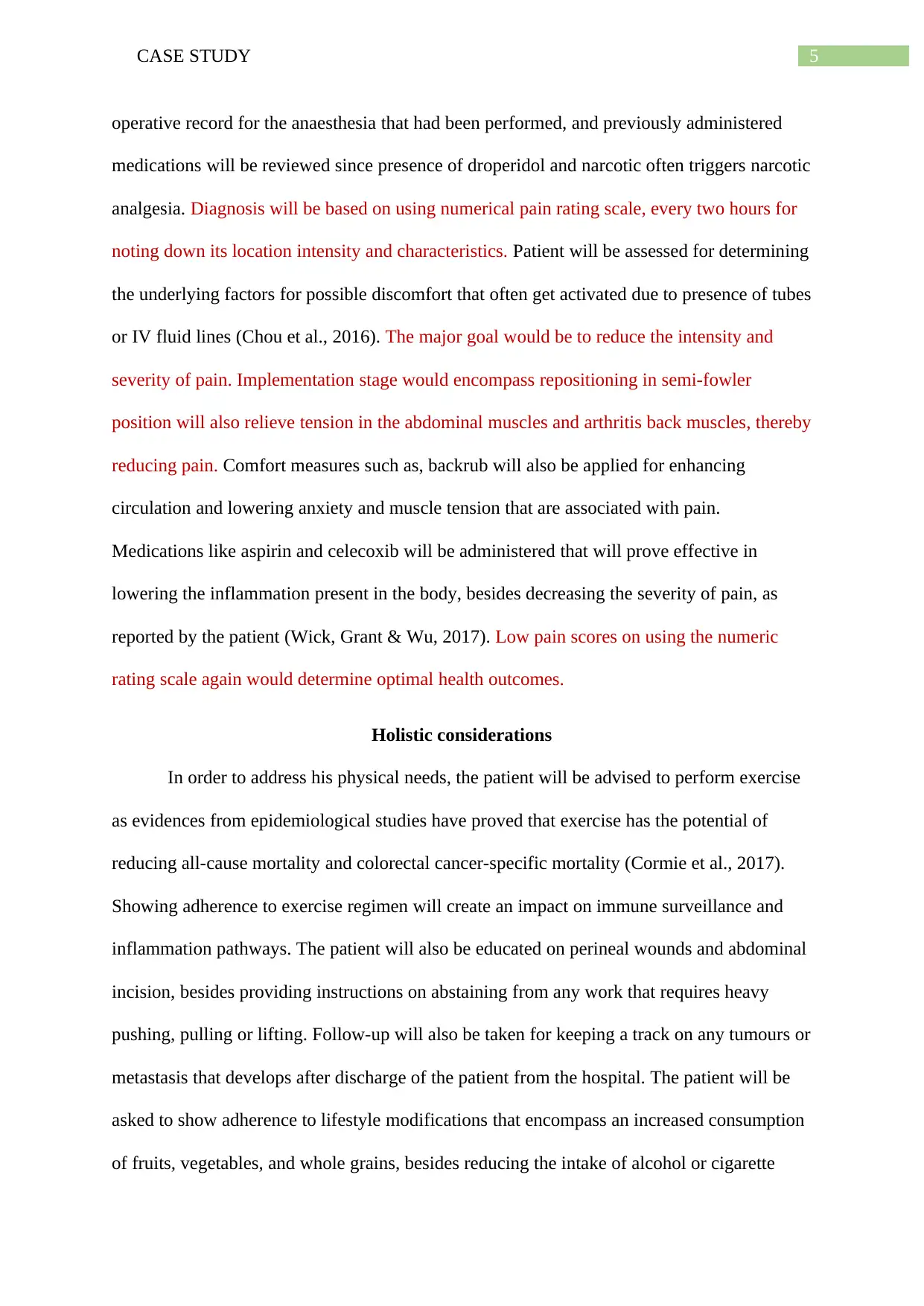
5CASE STUDY
operative record for the anaesthesia that had been performed, and previously administered
medications will be reviewed since presence of droperidol and narcotic often triggers narcotic
analgesia. Diagnosis will be based on using numerical pain rating scale, every two hours for
noting down its location intensity and characteristics. Patient will be assessed for determining
the underlying factors for possible discomfort that often get activated due to presence of tubes
or IV fluid lines (Chou et al., 2016). The major goal would be to reduce the intensity and
severity of pain. Implementation stage would encompass repositioning in semi-fowler
position will also relieve tension in the abdominal muscles and arthritis back muscles, thereby
reducing pain. Comfort measures such as, backrub will also be applied for enhancing
circulation and lowering anxiety and muscle tension that are associated with pain.
Medications like aspirin and celecoxib will be administered that will prove effective in
lowering the inflammation present in the body, besides decreasing the severity of pain, as
reported by the patient (Wick, Grant & Wu, 2017). Low pain scores on using the numeric
rating scale again would determine optimal health outcomes.
Holistic considerations
In order to address his physical needs, the patient will be advised to perform exercise
as evidences from epidemiological studies have proved that exercise has the potential of
reducing all-cause mortality and colorectal cancer-specific mortality (Cormie et al., 2017).
Showing adherence to exercise regimen will create an impact on immune surveillance and
inflammation pathways. The patient will also be educated on perineal wounds and abdominal
incision, besides providing instructions on abstaining from any work that requires heavy
pushing, pulling or lifting. Follow-up will also be taken for keeping a track on any tumours or
metastasis that develops after discharge of the patient from the hospital. The patient will be
asked to show adherence to lifestyle modifications that encompass an increased consumption
of fruits, vegetables, and whole grains, besides reducing the intake of alcohol or cigarette
operative record for the anaesthesia that had been performed, and previously administered
medications will be reviewed since presence of droperidol and narcotic often triggers narcotic
analgesia. Diagnosis will be based on using numerical pain rating scale, every two hours for
noting down its location intensity and characteristics. Patient will be assessed for determining
the underlying factors for possible discomfort that often get activated due to presence of tubes
or IV fluid lines (Chou et al., 2016). The major goal would be to reduce the intensity and
severity of pain. Implementation stage would encompass repositioning in semi-fowler
position will also relieve tension in the abdominal muscles and arthritis back muscles, thereby
reducing pain. Comfort measures such as, backrub will also be applied for enhancing
circulation and lowering anxiety and muscle tension that are associated with pain.
Medications like aspirin and celecoxib will be administered that will prove effective in
lowering the inflammation present in the body, besides decreasing the severity of pain, as
reported by the patient (Wick, Grant & Wu, 2017). Low pain scores on using the numeric
rating scale again would determine optimal health outcomes.
Holistic considerations
In order to address his physical needs, the patient will be advised to perform exercise
as evidences from epidemiological studies have proved that exercise has the potential of
reducing all-cause mortality and colorectal cancer-specific mortality (Cormie et al., 2017).
Showing adherence to exercise regimen will create an impact on immune surveillance and
inflammation pathways. The patient will also be educated on perineal wounds and abdominal
incision, besides providing instructions on abstaining from any work that requires heavy
pushing, pulling or lifting. Follow-up will also be taken for keeping a track on any tumours or
metastasis that develops after discharge of the patient from the hospital. The patient will be
asked to show adherence to lifestyle modifications that encompass an increased consumption
of fruits, vegetables, and whole grains, besides reducing the intake of alcohol or cigarette
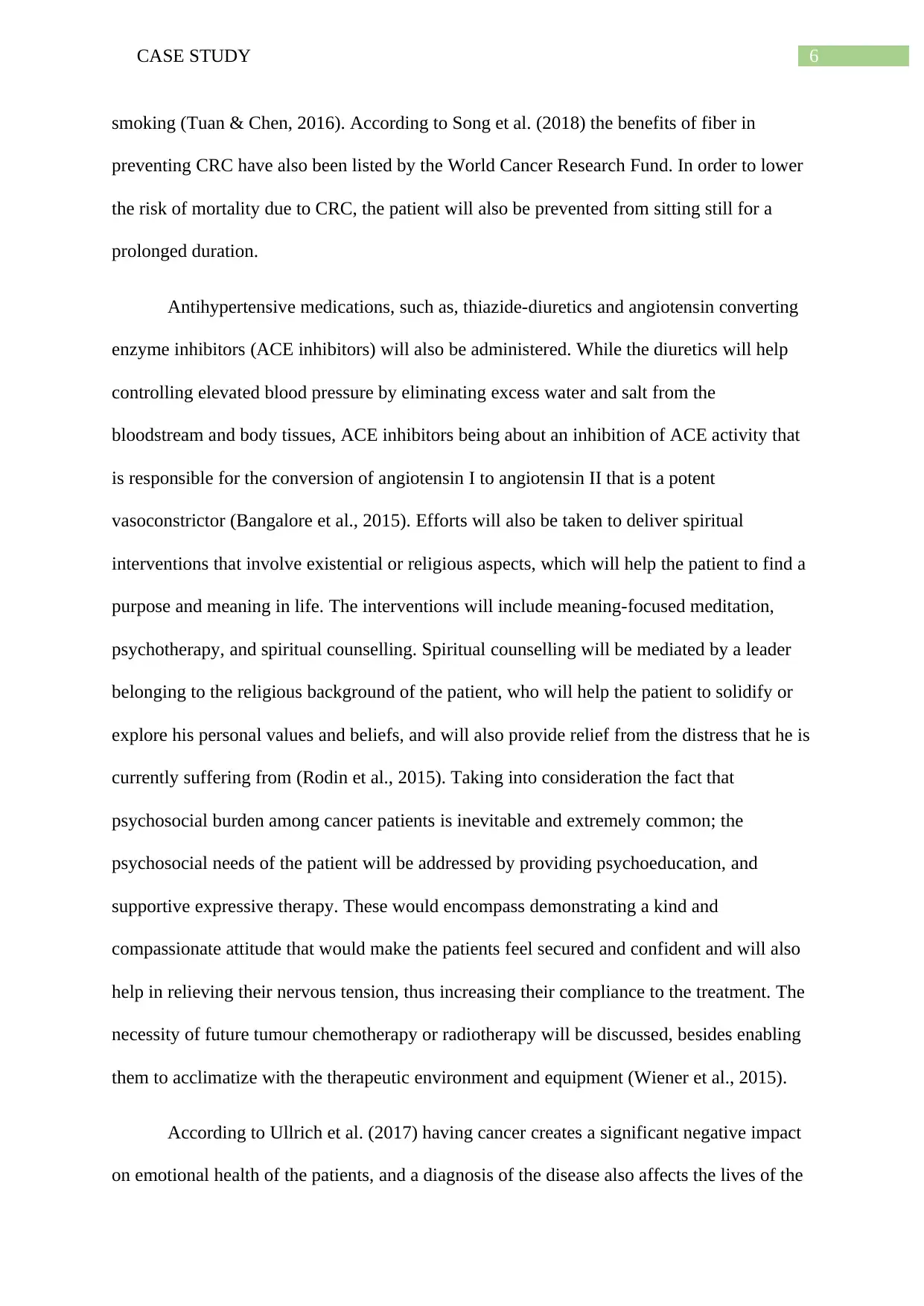
6CASE STUDY
smoking (Tuan & Chen, 2016). According to Song et al. (2018) the benefits of fiber in
preventing CRC have also been listed by the World Cancer Research Fund. In order to lower
the risk of mortality due to CRC, the patient will also be prevented from sitting still for a
prolonged duration.
Antihypertensive medications, such as, thiazide-diuretics and angiotensin converting
enzyme inhibitors (ACE inhibitors) will also be administered. While the diuretics will help
controlling elevated blood pressure by eliminating excess water and salt from the
bloodstream and body tissues, ACE inhibitors being about an inhibition of ACE activity that
is responsible for the conversion of angiotensin I to angiotensin II that is a potent
vasoconstrictor (Bangalore et al., 2015). Efforts will also be taken to deliver spiritual
interventions that involve existential or religious aspects, which will help the patient to find a
purpose and meaning in life. The interventions will include meaning-focused meditation,
psychotherapy, and spiritual counselling. Spiritual counselling will be mediated by a leader
belonging to the religious background of the patient, who will help the patient to solidify or
explore his personal values and beliefs, and will also provide relief from the distress that he is
currently suffering from (Rodin et al., 2015). Taking into consideration the fact that
psychosocial burden among cancer patients is inevitable and extremely common; the
psychosocial needs of the patient will be addressed by providing psychoeducation, and
supportive expressive therapy. These would encompass demonstrating a kind and
compassionate attitude that would make the patients feel secured and confident and will also
help in relieving their nervous tension, thus increasing their compliance to the treatment. The
necessity of future tumour chemotherapy or radiotherapy will be discussed, besides enabling
them to acclimatize with the therapeutic environment and equipment (Wiener et al., 2015).
According to Ullrich et al. (2017) having cancer creates a significant negative impact
on emotional health of the patients, and a diagnosis of the disease also affects the lives of the
smoking (Tuan & Chen, 2016). According to Song et al. (2018) the benefits of fiber in
preventing CRC have also been listed by the World Cancer Research Fund. In order to lower
the risk of mortality due to CRC, the patient will also be prevented from sitting still for a
prolonged duration.
Antihypertensive medications, such as, thiazide-diuretics and angiotensin converting
enzyme inhibitors (ACE inhibitors) will also be administered. While the diuretics will help
controlling elevated blood pressure by eliminating excess water and salt from the
bloodstream and body tissues, ACE inhibitors being about an inhibition of ACE activity that
is responsible for the conversion of angiotensin I to angiotensin II that is a potent
vasoconstrictor (Bangalore et al., 2015). Efforts will also be taken to deliver spiritual
interventions that involve existential or religious aspects, which will help the patient to find a
purpose and meaning in life. The interventions will include meaning-focused meditation,
psychotherapy, and spiritual counselling. Spiritual counselling will be mediated by a leader
belonging to the religious background of the patient, who will help the patient to solidify or
explore his personal values and beliefs, and will also provide relief from the distress that he is
currently suffering from (Rodin et al., 2015). Taking into consideration the fact that
psychosocial burden among cancer patients is inevitable and extremely common; the
psychosocial needs of the patient will be addressed by providing psychoeducation, and
supportive expressive therapy. These would encompass demonstrating a kind and
compassionate attitude that would make the patients feel secured and confident and will also
help in relieving their nervous tension, thus increasing their compliance to the treatment. The
necessity of future tumour chemotherapy or radiotherapy will be discussed, besides enabling
them to acclimatize with the therapeutic environment and equipment (Wiener et al., 2015).
According to Ullrich et al. (2017) having cancer creates a significant negative impact
on emotional health of the patients, and a diagnosis of the disease also affects the lives of the
Paraphrase This Document
Need a fresh take? Get an instant paraphrase of this document with our AI Paraphraser
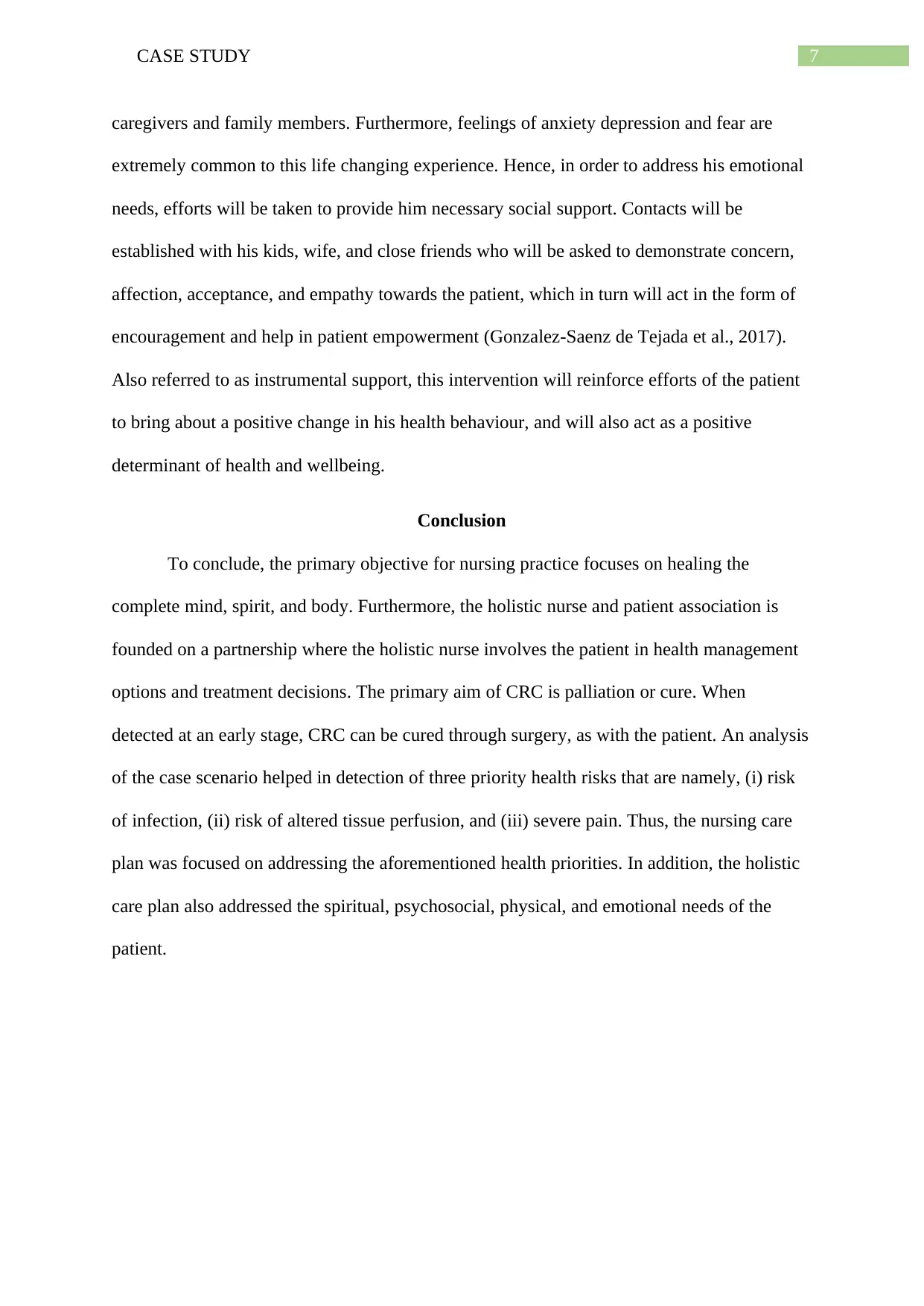
7CASE STUDY
caregivers and family members. Furthermore, feelings of anxiety depression and fear are
extremely common to this life changing experience. Hence, in order to address his emotional
needs, efforts will be taken to provide him necessary social support. Contacts will be
established with his kids, wife, and close friends who will be asked to demonstrate concern,
affection, acceptance, and empathy towards the patient, which in turn will act in the form of
encouragement and help in patient empowerment (Gonzalez‐Saenz de Tejada et al., 2017).
Also referred to as instrumental support, this intervention will reinforce efforts of the patient
to bring about a positive change in his health behaviour, and will also act as a positive
determinant of health and wellbeing.
Conclusion
To conclude, the primary objective for nursing practice focuses on healing the
complete mind, spirit, and body. Furthermore, the holistic nurse and patient association is
founded on a partnership where the holistic nurse involves the patient in health management
options and treatment decisions. The primary aim of CRC is palliation or cure. When
detected at an early stage, CRC can be cured through surgery, as with the patient. An analysis
of the case scenario helped in detection of three priority health risks that are namely, (i) risk
of infection, (ii) risk of altered tissue perfusion, and (iii) severe pain. Thus, the nursing care
plan was focused on addressing the aforementioned health priorities. In addition, the holistic
care plan also addressed the spiritual, psychosocial, physical, and emotional needs of the
patient.
caregivers and family members. Furthermore, feelings of anxiety depression and fear are
extremely common to this life changing experience. Hence, in order to address his emotional
needs, efforts will be taken to provide him necessary social support. Contacts will be
established with his kids, wife, and close friends who will be asked to demonstrate concern,
affection, acceptance, and empathy towards the patient, which in turn will act in the form of
encouragement and help in patient empowerment (Gonzalez‐Saenz de Tejada et al., 2017).
Also referred to as instrumental support, this intervention will reinforce efforts of the patient
to bring about a positive change in his health behaviour, and will also act as a positive
determinant of health and wellbeing.
Conclusion
To conclude, the primary objective for nursing practice focuses on healing the
complete mind, spirit, and body. Furthermore, the holistic nurse and patient association is
founded on a partnership where the holistic nurse involves the patient in health management
options and treatment decisions. The primary aim of CRC is palliation or cure. When
detected at an early stage, CRC can be cured through surgery, as with the patient. An analysis
of the case scenario helped in detection of three priority health risks that are namely, (i) risk
of infection, (ii) risk of altered tissue perfusion, and (iii) severe pain. Thus, the nursing care
plan was focused on addressing the aforementioned health priorities. In addition, the holistic
care plan also addressed the spiritual, psychosocial, physical, and emotional needs of the
patient.
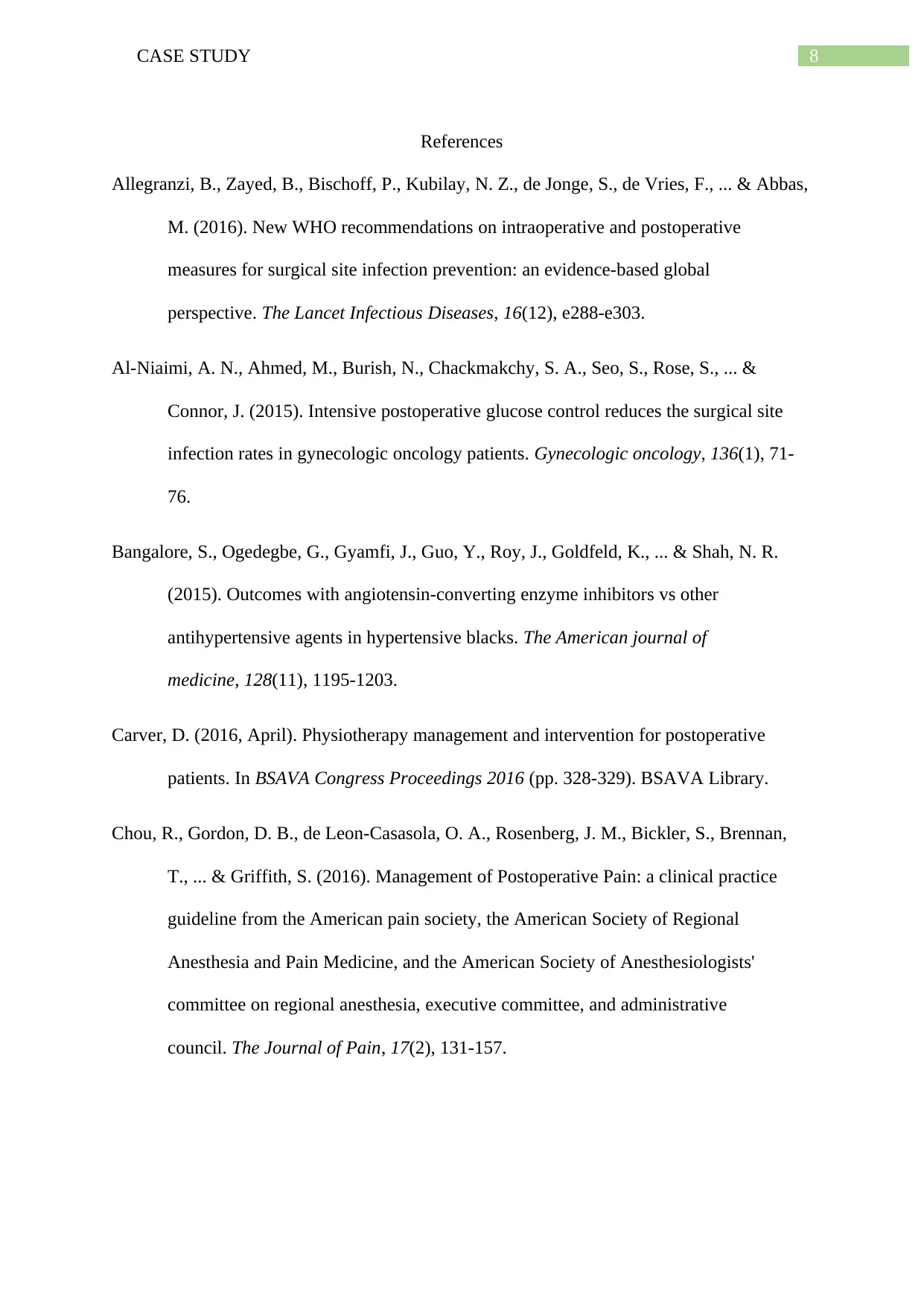
8CASE STUDY
References
Allegranzi, B., Zayed, B., Bischoff, P., Kubilay, N. Z., de Jonge, S., de Vries, F., ... & Abbas,
M. (2016). New WHO recommendations on intraoperative and postoperative
measures for surgical site infection prevention: an evidence-based global
perspective. The Lancet Infectious Diseases, 16(12), e288-e303.
Al-Niaimi, A. N., Ahmed, M., Burish, N., Chackmakchy, S. A., Seo, S., Rose, S., ... &
Connor, J. (2015). Intensive postoperative glucose control reduces the surgical site
infection rates in gynecologic oncology patients. Gynecologic oncology, 136(1), 71-
76.
Bangalore, S., Ogedegbe, G., Gyamfi, J., Guo, Y., Roy, J., Goldfeld, K., ... & Shah, N. R.
(2015). Outcomes with angiotensin-converting enzyme inhibitors vs other
antihypertensive agents in hypertensive blacks. The American journal of
medicine, 128(11), 1195-1203.
Carver, D. (2016, April). Physiotherapy management and intervention for postoperative
patients. In BSAVA Congress Proceedings 2016 (pp. 328-329). BSAVA Library.
Chou, R., Gordon, D. B., de Leon-Casasola, O. A., Rosenberg, J. M., Bickler, S., Brennan,
T., ... & Griffith, S. (2016). Management of Postoperative Pain: a clinical practice
guideline from the American pain society, the American Society of Regional
Anesthesia and Pain Medicine, and the American Society of Anesthesiologists'
committee on regional anesthesia, executive committee, and administrative
council. The Journal of Pain, 17(2), 131-157.
References
Allegranzi, B., Zayed, B., Bischoff, P., Kubilay, N. Z., de Jonge, S., de Vries, F., ... & Abbas,
M. (2016). New WHO recommendations on intraoperative and postoperative
measures for surgical site infection prevention: an evidence-based global
perspective. The Lancet Infectious Diseases, 16(12), e288-e303.
Al-Niaimi, A. N., Ahmed, M., Burish, N., Chackmakchy, S. A., Seo, S., Rose, S., ... &
Connor, J. (2015). Intensive postoperative glucose control reduces the surgical site
infection rates in gynecologic oncology patients. Gynecologic oncology, 136(1), 71-
76.
Bangalore, S., Ogedegbe, G., Gyamfi, J., Guo, Y., Roy, J., Goldfeld, K., ... & Shah, N. R.
(2015). Outcomes with angiotensin-converting enzyme inhibitors vs other
antihypertensive agents in hypertensive blacks. The American journal of
medicine, 128(11), 1195-1203.
Carver, D. (2016, April). Physiotherapy management and intervention for postoperative
patients. In BSAVA Congress Proceedings 2016 (pp. 328-329). BSAVA Library.
Chou, R., Gordon, D. B., de Leon-Casasola, O. A., Rosenberg, J. M., Bickler, S., Brennan,
T., ... & Griffith, S. (2016). Management of Postoperative Pain: a clinical practice
guideline from the American pain society, the American Society of Regional
Anesthesia and Pain Medicine, and the American Society of Anesthesiologists'
committee on regional anesthesia, executive committee, and administrative
council. The Journal of Pain, 17(2), 131-157.
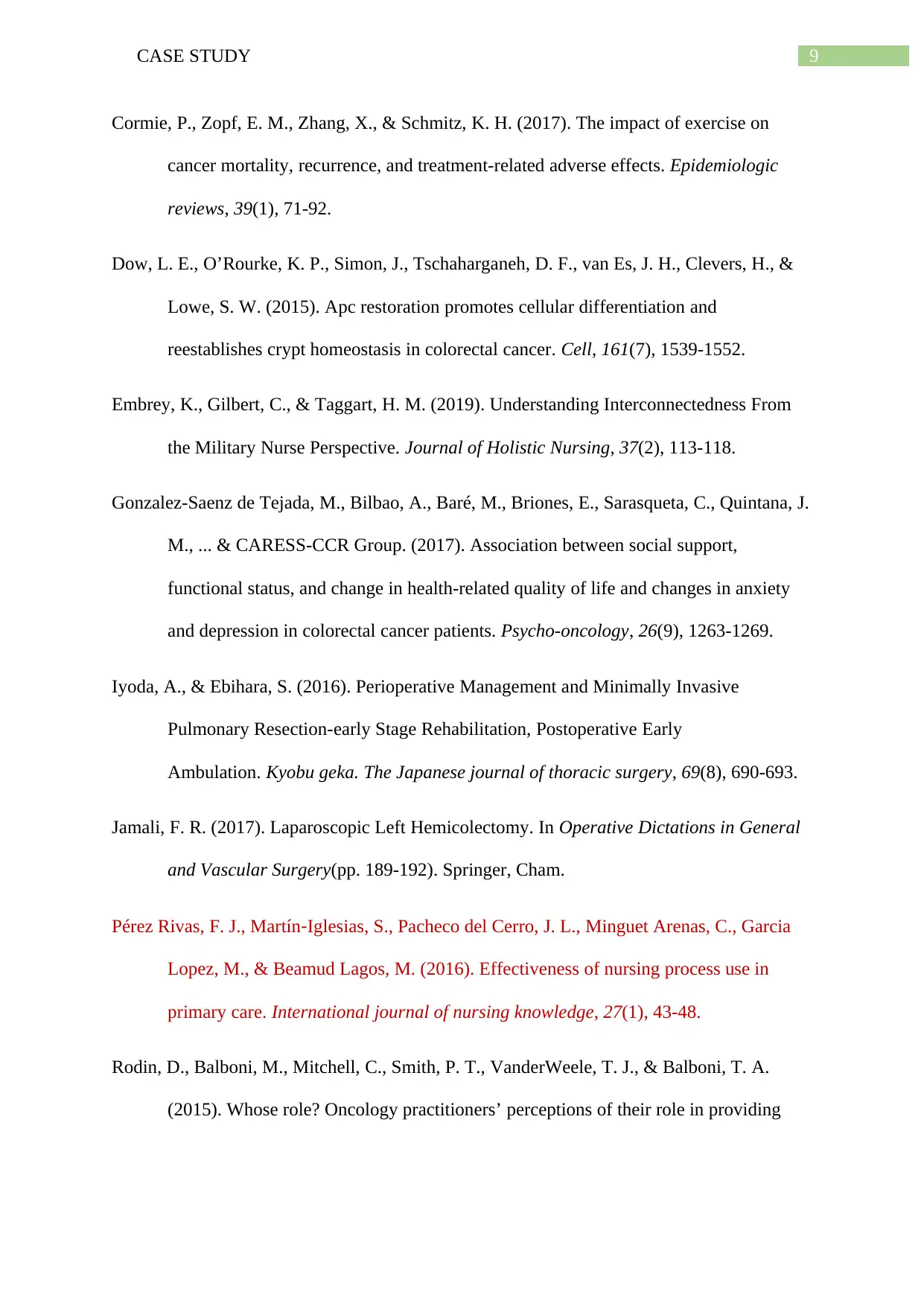
9CASE STUDY
Cormie, P., Zopf, E. M., Zhang, X., & Schmitz, K. H. (2017). The impact of exercise on
cancer mortality, recurrence, and treatment-related adverse effects. Epidemiologic
reviews, 39(1), 71-92.
Dow, L. E., O’Rourke, K. P., Simon, J., Tschaharganeh, D. F., van Es, J. H., Clevers, H., &
Lowe, S. W. (2015). Apc restoration promotes cellular differentiation and
reestablishes crypt homeostasis in colorectal cancer. Cell, 161(7), 1539-1552.
Embrey, K., Gilbert, C., & Taggart, H. M. (2019). Understanding Interconnectedness From
the Military Nurse Perspective. Journal of Holistic Nursing, 37(2), 113-118.
Gonzalez‐Saenz de Tejada, M., Bilbao, A., Baré, M., Briones, E., Sarasqueta, C., Quintana, J.
M., ... & CARESS‐CCR Group. (2017). Association between social support,
functional status, and change in health‐related quality of life and changes in anxiety
and depression in colorectal cancer patients. Psycho‐oncology, 26(9), 1263-1269.
Iyoda, A., & Ebihara, S. (2016). Perioperative Management and Minimally Invasive
Pulmonary Resection-early Stage Rehabilitation, Postoperative Early
Ambulation. Kyobu geka. The Japanese journal of thoracic surgery, 69(8), 690-693.
Jamali, F. R. (2017). Laparoscopic Left Hemicolectomy. In Operative Dictations in General
and Vascular Surgery(pp. 189-192). Springer, Cham.
Pérez Rivas, F. J., Martín‐Iglesias, S., Pacheco del Cerro, J. L., Minguet Arenas, C., Garcia
Lopez, M., & Beamud Lagos, M. (2016). Effectiveness of nursing process use in
primary care. International journal of nursing knowledge, 27(1), 43-48.
Rodin, D., Balboni, M., Mitchell, C., Smith, P. T., VanderWeele, T. J., & Balboni, T. A.
(2015). Whose role? Oncology practitioners’ perceptions of their role in providing
Cormie, P., Zopf, E. M., Zhang, X., & Schmitz, K. H. (2017). The impact of exercise on
cancer mortality, recurrence, and treatment-related adverse effects. Epidemiologic
reviews, 39(1), 71-92.
Dow, L. E., O’Rourke, K. P., Simon, J., Tschaharganeh, D. F., van Es, J. H., Clevers, H., &
Lowe, S. W. (2015). Apc restoration promotes cellular differentiation and
reestablishes crypt homeostasis in colorectal cancer. Cell, 161(7), 1539-1552.
Embrey, K., Gilbert, C., & Taggart, H. M. (2019). Understanding Interconnectedness From
the Military Nurse Perspective. Journal of Holistic Nursing, 37(2), 113-118.
Gonzalez‐Saenz de Tejada, M., Bilbao, A., Baré, M., Briones, E., Sarasqueta, C., Quintana, J.
M., ... & CARESS‐CCR Group. (2017). Association between social support,
functional status, and change in health‐related quality of life and changes in anxiety
and depression in colorectal cancer patients. Psycho‐oncology, 26(9), 1263-1269.
Iyoda, A., & Ebihara, S. (2016). Perioperative Management and Minimally Invasive
Pulmonary Resection-early Stage Rehabilitation, Postoperative Early
Ambulation. Kyobu geka. The Japanese journal of thoracic surgery, 69(8), 690-693.
Jamali, F. R. (2017). Laparoscopic Left Hemicolectomy. In Operative Dictations in General
and Vascular Surgery(pp. 189-192). Springer, Cham.
Pérez Rivas, F. J., Martín‐Iglesias, S., Pacheco del Cerro, J. L., Minguet Arenas, C., Garcia
Lopez, M., & Beamud Lagos, M. (2016). Effectiveness of nursing process use in
primary care. International journal of nursing knowledge, 27(1), 43-48.
Rodin, D., Balboni, M., Mitchell, C., Smith, P. T., VanderWeele, T. J., & Balboni, T. A.
(2015). Whose role? Oncology practitioners’ perceptions of their role in providing
Secure Best Marks with AI Grader
Need help grading? Try our AI Grader for instant feedback on your assignments.
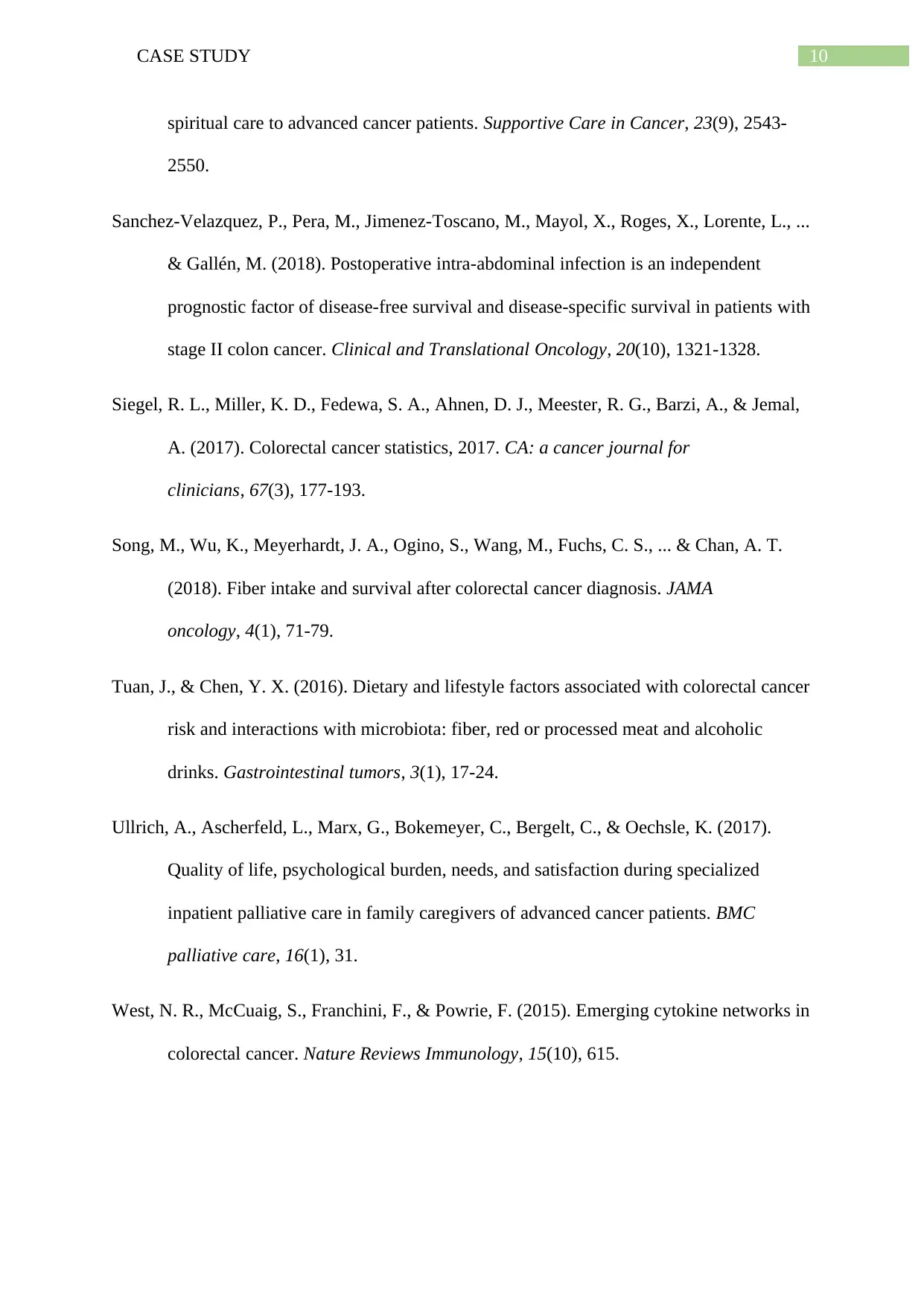
10CASE STUDY
spiritual care to advanced cancer patients. Supportive Care in Cancer, 23(9), 2543-
2550.
Sanchez-Velazquez, P., Pera, M., Jimenez-Toscano, M., Mayol, X., Roges, X., Lorente, L., ...
& Gallén, M. (2018). Postoperative intra-abdominal infection is an independent
prognostic factor of disease-free survival and disease-specific survival in patients with
stage II colon cancer. Clinical and Translational Oncology, 20(10), 1321-1328.
Siegel, R. L., Miller, K. D., Fedewa, S. A., Ahnen, D. J., Meester, R. G., Barzi, A., & Jemal,
A. (2017). Colorectal cancer statistics, 2017. CA: a cancer journal for
clinicians, 67(3), 177-193.
Song, M., Wu, K., Meyerhardt, J. A., Ogino, S., Wang, M., Fuchs, C. S., ... & Chan, A. T.
(2018). Fiber intake and survival after colorectal cancer diagnosis. JAMA
oncology, 4(1), 71-79.
Tuan, J., & Chen, Y. X. (2016). Dietary and lifestyle factors associated with colorectal cancer
risk and interactions with microbiota: fiber, red or processed meat and alcoholic
drinks. Gastrointestinal tumors, 3(1), 17-24.
Ullrich, A., Ascherfeld, L., Marx, G., Bokemeyer, C., Bergelt, C., & Oechsle, K. (2017).
Quality of life, psychological burden, needs, and satisfaction during specialized
inpatient palliative care in family caregivers of advanced cancer patients. BMC
palliative care, 16(1), 31.
West, N. R., McCuaig, S., Franchini, F., & Powrie, F. (2015). Emerging cytokine networks in
colorectal cancer. Nature Reviews Immunology, 15(10), 615.
spiritual care to advanced cancer patients. Supportive Care in Cancer, 23(9), 2543-
2550.
Sanchez-Velazquez, P., Pera, M., Jimenez-Toscano, M., Mayol, X., Roges, X., Lorente, L., ...
& Gallén, M. (2018). Postoperative intra-abdominal infection is an independent
prognostic factor of disease-free survival and disease-specific survival in patients with
stage II colon cancer. Clinical and Translational Oncology, 20(10), 1321-1328.
Siegel, R. L., Miller, K. D., Fedewa, S. A., Ahnen, D. J., Meester, R. G., Barzi, A., & Jemal,
A. (2017). Colorectal cancer statistics, 2017. CA: a cancer journal for
clinicians, 67(3), 177-193.
Song, M., Wu, K., Meyerhardt, J. A., Ogino, S., Wang, M., Fuchs, C. S., ... & Chan, A. T.
(2018). Fiber intake and survival after colorectal cancer diagnosis. JAMA
oncology, 4(1), 71-79.
Tuan, J., & Chen, Y. X. (2016). Dietary and lifestyle factors associated with colorectal cancer
risk and interactions with microbiota: fiber, red or processed meat and alcoholic
drinks. Gastrointestinal tumors, 3(1), 17-24.
Ullrich, A., Ascherfeld, L., Marx, G., Bokemeyer, C., Bergelt, C., & Oechsle, K. (2017).
Quality of life, psychological burden, needs, and satisfaction during specialized
inpatient palliative care in family caregivers of advanced cancer patients. BMC
palliative care, 16(1), 31.
West, N. R., McCuaig, S., Franchini, F., & Powrie, F. (2015). Emerging cytokine networks in
colorectal cancer. Nature Reviews Immunology, 15(10), 615.
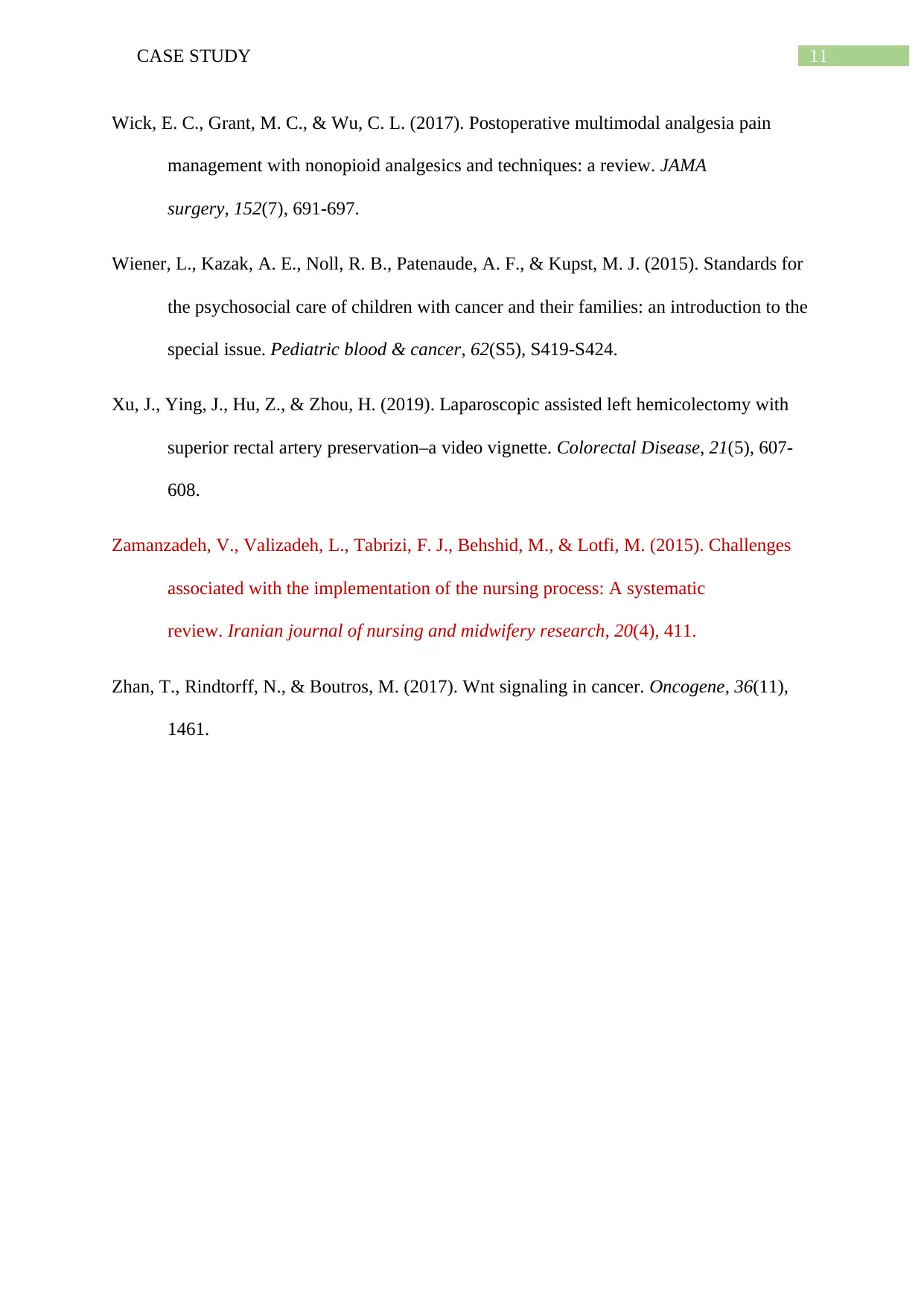
11CASE STUDY
Wick, E. C., Grant, M. C., & Wu, C. L. (2017). Postoperative multimodal analgesia pain
management with nonopioid analgesics and techniques: a review. JAMA
surgery, 152(7), 691-697.
Wiener, L., Kazak, A. E., Noll, R. B., Patenaude, A. F., & Kupst, M. J. (2015). Standards for
the psychosocial care of children with cancer and their families: an introduction to the
special issue. Pediatric blood & cancer, 62(S5), S419-S424.
Xu, J., Ying, J., Hu, Z., & Zhou, H. (2019). Laparoscopic assisted left hemicolectomy with
superior rectal artery preservation–a video vignette. Colorectal Disease, 21(5), 607-
608.
Zamanzadeh, V., Valizadeh, L., Tabrizi, F. J., Behshid, M., & Lotfi, M. (2015). Challenges
associated with the implementation of the nursing process: A systematic
review. Iranian journal of nursing and midwifery research, 20(4), 411.
Zhan, T., Rindtorff, N., & Boutros, M. (2017). Wnt signaling in cancer. Oncogene, 36(11),
1461.
Wick, E. C., Grant, M. C., & Wu, C. L. (2017). Postoperative multimodal analgesia pain
management with nonopioid analgesics and techniques: a review. JAMA
surgery, 152(7), 691-697.
Wiener, L., Kazak, A. E., Noll, R. B., Patenaude, A. F., & Kupst, M. J. (2015). Standards for
the psychosocial care of children with cancer and their families: an introduction to the
special issue. Pediatric blood & cancer, 62(S5), S419-S424.
Xu, J., Ying, J., Hu, Z., & Zhou, H. (2019). Laparoscopic assisted left hemicolectomy with
superior rectal artery preservation–a video vignette. Colorectal Disease, 21(5), 607-
608.
Zamanzadeh, V., Valizadeh, L., Tabrizi, F. J., Behshid, M., & Lotfi, M. (2015). Challenges
associated with the implementation of the nursing process: A systematic
review. Iranian journal of nursing and midwifery research, 20(4), 411.
Zhan, T., Rindtorff, N., & Boutros, M. (2017). Wnt signaling in cancer. Oncogene, 36(11),
1461.
1 out of 12
Your All-in-One AI-Powered Toolkit for Academic Success.
+13062052269
info@desklib.com
Available 24*7 on WhatsApp / Email
![[object Object]](/_next/static/media/star-bottom.7253800d.svg)
Unlock your academic potential
© 2024 | Zucol Services PVT LTD | All rights reserved.


